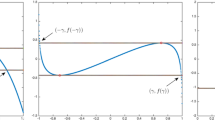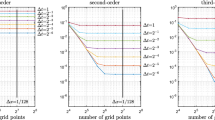Abstract
In this work, we develop a class of up to eighth-order maximum-principle-preserving (MPP) methods for the Allen–Cahn equation. Beginning with the space-discrete system, we extend the integrating factor two-step Runge–Kutta (IFTSRK) methods and define sufficient conditions for the preservation of the discrete maximum principle. In particular, we combine the IFTSRK methods with the linear stabilization technique to develop the stabilized IFTSRK formulations and successfully derive sufficient conditions to preserve the discrete maximum principle unconditionally. Furthermore, we provide error estimates for these proposed methods. Numerical experiments are carried out to illustrate the high-order accuracy and MPP characteristic of the proposed methods and to verify the efficiency through simulations of the long-time evolutional behavior.












Similar content being viewed by others
Data availability
Data sharing not applicable to this article as no datasets were generated or analyzed during the current study.
References
Allen, S.M., Cahn, J.W.: A microscopic theory for antiphase boundary motion and its application to antiphase domain coarsening. Acta Metallurgica 27(6), 1085–1095 (1979)
Beneš, M., Chalupeckỳ, V., Mikula, K.: Geometrical image segmentation by the Allen–Cahn equation. Appl. Numer. Math. 51(2-3), 187–205 (2004)
Feng, X., Prohl, A.: Numerical analysis of the Allen–Cahn equation and approximation for mean curvature flows. Numer. Math. 94(1), 33–65 (2003)
Shen, J., Yang, X.: A phase-field model and its numerical approximation for two-phase incompressible flows with different densities and viscosities. SIAM Journal on Scientific Computing 32(3), 1159–1179 (2010)
Wheeler, A.A., Boettinger, W.J., McFadden, G.B.: Phase–field model for isothermal phase transitions in binary alloys. Phys. Rev. A 45(10), 7424 (1992)
Du, Q., Nicolaides, R.A.: Numerical analysis of a continuum model of phase transition. SIAM J. on Numer. Anal. 28(5), 1310–1322 (1991)
Elliott, C.M., Stuart, A.M.: The global dynamics of discrete semilinear parabolic equations. SIAM J. on Numer. Anal. 30(6), 1622–1663 (1993)
Shen, J., Yang, X.: Numerical approximations of Allen–Cahn and Cahn–Hilliard equations. Discrete Contin. Dyn. Syst-A 28(4), 1669 (2010)
Yang, X.: Linear, first and second-order, unconditionally energy stable numerical schemes for the phase field model of homopolymer blends. J. of Comput. Phys. 327, 294–316 (2016)
Shen, J., Xu, J., Yang, J.: The scalar auxiliary variable (SAV) approach for gradient flows. J. of Comput. Phys. 353, 407–416 (2018)
Sun, J., Qian, X., Zhang, H., Song, S.: Novel energy dissipative method on the adaptive spatial discretization for the Allen–Cahn equation. Chin. Phys. B 30(7), 070201 (2021)
Du, Q., Gunzburger, M.D., Peterson, J.S.: Analysis and approximation of the Ginzburg–Landau model of superconductivity. SIAM Rev. 34(1), 54–81 (1992)
Evans, L.C., Soner, H.M., Souganidis, P.E.: Phase transitions and generalized motion by mean curvature. Commun. on Pure and Appl. Math. 45(9), 1097–1123 (1992)
Ju, L., Li, X., Qiao, Z., Yang, J.: Maximum bound principle preserving integrating factor Runge—Kutta methods for semilinear parabolic equations. J Comput. Phys. 439, 110405 (2021)
Hou, T., Tang, T., Yang, J.: Numerical analysis of fully discretized Crank–Nicolson scheme for fractional-in-space Allen–Cahn equations. J. of Sci. Comput. 72(3), 1214–1231 (2017)
Shen, J., Tang, T., Yang, J.: On the maximum principle preserving schemes for the generalized Allen–Cahn equation. Commun. in Math. Sci. 14(6), 1517–1534 (2016)
Tang, T., Yang, J.: Implicit-explicit scheme for the Allen–Cahn equation preserves the maximum principle. J. of Comput. Math. 34(5), 451 (2016)
Du, Q., Ju, L., Li, X., Qiao, Z.: Maximum principle preserving exponential time differencing schemes for the nonlocal Allen–Cahn equation. SIAM J. on Numer. Anal. 57(2), 875–898 (2019)
Hou, T, Xiu, D., Jiang, W.: A new second-order maximum-principle preserving finite difference scheme for Allen–Cahn equations with periodic boundary conditions. Appl. Math. Lett. 104, 106265 (2020)
Liao, H., Tang, T., Zhou, T.: A second-order and nonuniform time-stepping maximum-principle preserving scheme for time-fractional Allen-Cahn equations. J Comput. Phys. 414, 109473 (2020)
Gottlieb, S., Shu, C.-W.: Total variation diminishing Runge-Kutta schemes. Math. Comput. 67(221), 73–85 (1998)
Gottlieb, S., Shu, C.-W., Tadmor, E.: Strong stability-preserving high-order time discretization methods. SIAM Rev. 43(1), 89–112 (2001)
Shu, C.-W., Osher, S.: Efficient implementation of essentially non-oscillatory shock-capturing schemes. J. Comput. Phys. 77(2), 439–471 (1988)
Leah, I., J, G.Z., Sigal, G.: Strong stability preserving integrating factor Runge–Kutta methods. SIAM J. on Numer. Anal. 56(6), 3276–3307 (2018)
Chollom, J., Jackiewicz, Z.: Construction of two-step Runge—Kutta methods with large regions of absolute stability. J. of Comput. and Appl. Math. 157(1), 125–137 (2003)
Jackiewicz, Z., Renaut, R., Feldstein, A.: Two-step Runge–Kutta methods. SIAM J. on Numer. Anal. 28(4), 1165–1182 (1991)
Jackiewicz, Z., Tracogna, S.: A general class of two-step Runge–Kutta methods for ordinary differential equations. SIAM J. on Numer. Anal. 32(5), 1390–1427 (1995)
Jackiewicz, Z., Tracogna, S.: Variable stepsize continuous two-step Runge-Kutta methods for ordinary differential equations. Numer. Algorithms 12(2), 347–368 (1996)
Eyre, D.: An unconditionally stable one-step scheme for gradient systems, Unpublished article. pp. 1–15 (1998)
Guo, J., Wang, C., Wise, S.M., Yue, X.: An h2 convergence of a second-order convex-splitting, finite difference scheme for the three-dimensional Cahn-Hilliard equation. Commun. in Math. Sci. 14(2), 489–515 (2016)
Li, Y., Lee, H.G., Jeong, D., Kim, J.: An unconditionally stable hybrid numerical method for solving the Allen–Cahn equation. Comput Math. Appl. 60(6), 1591–1606 (2010)
Xu, C., Tang, T.: Stability analysis of large time-stepping methods for epitaxial growth models. SIAM J. on Numer. Anal. 44(4), 1759–1779 (2006)
Du, Q., Ju, L., Li, X., Qiao, Z.: Maximum bound principles for a class of semilinear parabolic equations and exponential time differencing schemes. SIAM Rev. 63(2), 317–359 (2021)
He, D., Pan, K., Hu, H.: A spatial fourth-order maximum principle preserving operator splitting scheme for the multi-dimensional fractional Allen-Cahn equation. Appl. Numer. Math. 151, 44–63 (2020)
Zhai, S, Ye, C., Weng, Z.: A fast and efficient numerical algorithm for fractional Allen–Cahn with precise nonlocal mass conservation. Appl. Math. Lett. 103, 106190 (2020)
Li, B., Yang, J., Zhou, Z.: Arbitrarily High-Order exponential cut-off methods for preserving maximum bound principle of parabolic equations. SIAM J. on Sci. Comput. 42(6), A3957–A3978 (2020)
Yang, J., Yuan, Z., Zhou, Z.: Arbitrarily high-order maximum bound preserving schemes with cut-off postprocessing for Allen–Cahn equations. arXiv:2102.13271 (2021)
Li, J., Li, X., Ju, L., Feng, X.: Stabilized integrating factor Runge–Kutta method and unconditional preservation of maximum bound principle. SIAM J. on Sci. Comput. 43(3), A1780–A1802 (2021)
Zhang, H., Yan, J., Qian, X., Song, S.: Numerical analysis and applications of explicit high order maximum principle preserving integrating factor Runge–Kutta schemes for Allen–Cahn equation. Appl. Numer. Math. 161, 372–390 (2021)
Gong, Y., Wang, Q., Wang, Y., Cai, J.: A conservative Fourier pseudo-spectral method for the nonlinear schrödinger equation. J. of Comput. Phys. 328, 354–370 (2017)
Leah, I., J, G.Z., Sigal, G.: Strong stability preserving integrating factor two-step Runge–Kutta methods. J. of Sci. Comput. 81(3), 1446–1471 (2019)
Douglas, J. Jr, Dupont T.: Alternating-direction Galerkin methods on rectangles. Numerical solution of partial differential equations-ii (1971)
Chen, W., Wang, C., Wang, X., Wise, S.: A linear iteration algorithm for a second-order energy stable scheme for a thin film model without slope selection. J. of Sci. Comput. 59(3), 574–601 (2014)
Duchemin, L., Eggers, J.: The explicit-implicit-null method: removing the numerical instability of pdes. J. of Comput. Phys. 263, 37–52 (2014)
Du, J., Yang, Y.: Third-order conservative sign-preserving and steady-state-preserving time integrations and applications in stiff multispecies and multireaction detonations. J. of Comput. Phys. 395, 489–510 (2019)
Zhang, H., Yan, J., Qian, X., Song, S.: Up to fourth-order unconditionally structure-preserving parametric single-step methods for semilinear parabolic equations, Computer Methods in Applied Mechanics and Engineering, accepted (2021)
Du, Q., Ju, L., Lu, J.: Analysis of fully discrete approximations for dissipative systems and application to time-dependent nonlocal diffusion problems. J. of Sci. Comput. 78(3), 1438–1466 (2019)
Ketcheson, G.S., I, D., macdonald, C.B.: Strong stability preserving two-step Runge–Kutta methods. SIAM J. on Numer. Anal. 49(6), 2618–2639 (2011)
Ketcheson, D.I.: Highly efficient strong stability-preserving Runge–Kutta methods with low-storage implementations. SIAM J. on Sci. Comput. 30(4), 2113–2136 (2008)
Xu, J., Li, Y., Wu, S., Bousquet, A.: On the stability and accuracy of partially and fully implicit schemes for phase field modeling. Comput. Methods in Appl. Mech. and Eng. 345, 826–853 (2019)
Acknowledgements
The authors sincerely thank the anonymous reviewers for their valuable suggestions, which helped improve this manuscript.
Funding
This research is supported by the National Key R&D Program of China (2020YFA0709803), the National Natural Science Foundation of China (No. 11901577, 11971481, 12071481), the Natural Science Foundation of Hunan (No. 2020JJ5652), the National Key Project (No.GJXM92579), the Defense Science Foundation of China (2021-JCJQ-JJ-0538) and the Research Fund of National University of Defense Technology (No. ZK19-37).
Author information
Authors and Affiliations
Corresponding author
Additional information
Publisher’s note
Springer Nature remains neutral with regard to jurisdictional claims in published maps and institutional affiliations.
Rights and permissions
About this article
Cite this article
Sun, J., Zhang, H., Qian, X. et al. Up to eighth-order maximum-principle-preserving methods for the Allen–Cahn equation. Numer Algor 92, 1041–1062 (2023). https://doi.org/10.1007/s11075-022-01329-4
Received:
Accepted:
Published:
Issue Date:
DOI: https://doi.org/10.1007/s11075-022-01329-4




